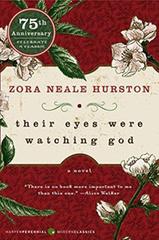 Their Eyes Were Watching God by Zora Neale Hurston tells the story of Janie Crawford, an African-American woman in the early 20th-century South whose life is defined by her marriages to three very different men. Janie is raised by her grandmother, who was born a slave, after Janie's mother runs away. As a teenager, Janie is forced to marry a much older man after she is caught kissing a boy her own age. Janie escapes a life of domestic servitude by running off with another man to Eatonville, Fla., where her ambitious second husband starts a successful business. Once again, however, Janie is treated more like property than partner. When her second husband dies, Janie marries a third, younger man, with mixed results. The novel is an extended flashback, told by a now autonomous Janie in her early 40s to a friend, in language punctuated by period vernacular.
Their Eyes Were Watching God by Zora Neale Hurston tells the story of Janie Crawford, an African-American woman in the early 20th-century South whose life is defined by her marriages to three very different men. Janie is raised by her grandmother, who was born a slave, after Janie's mother runs away. As a teenager, Janie is forced to marry a much older man after she is caught kissing a boy her own age. Janie escapes a life of domestic servitude by running off with another man to Eatonville, Fla., where her ambitious second husband starts a successful business. Once again, however, Janie is treated more like property than partner. When her second husband dies, Janie marries a third, younger man, with mixed results. The novel is an extended flashback, told by a now autonomous Janie in her early 40s to a friend, in language punctuated by period vernacular.
When Hurston (1891-1960) published her novel in 1937, it met with largely negative criticism from other African-American writers. Many black artists subscribed to the Racial Uplift program, an effort spearheaded by W.E.B. Du Bois to depict African-Americans in ways pleasing to popular, that is, mostly white, culture. Even members of the Harlem Renaissance, who rejected the Uplift's strict standards, found Hurston's book immodest. Her work went largely unrecognized until the 1970s, when Black Studies programs became common in American universities and academics like Henry Louis Gates, Jr. recognized the importance of Hurston's work. Today, Hurston's strong, black, female protagonist is situated squarely in the literary canon.
A 75th anniversary edition of Their Eyes Were Watching God was published by Harper Perennial in 2006 ($16.99, 9780061120060). The ebb of Black History Month into Women's History Month is an excellent opportunity to rediscover this classic. --Tobias Mutter

